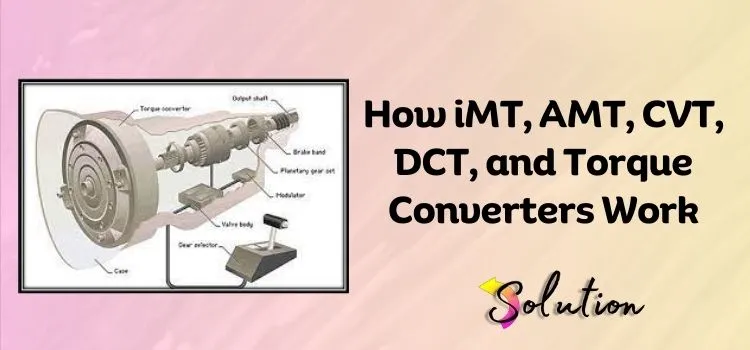
Five words, and five different vibes – iMT, AMT, CVT, DCT, and Torque Convertor. Each vibe is unique in its way and emotionally connected with drivers due to their specific functions and performance capabilities.
These five words represent the various types of transmission, which are essential for the seamless operation of modern vehicles. Transmission is what translates the engine’s power into motion, blending technology with the mechanics to deliver comfort, performance, and efficiency.
What if we told you that an automatic car’s driving pleasure lies not only in its convenience, but also in the advanced technology that operates seamlessly in the background to enhance your overall driving experience?
Each technology offers a combination of efficiency, smoothness, and responsiveness to cater to different driving preferences and needs. It combines the magic that car enthusiasts crave with the daily practicality that everyday drivers require, making automatic transmissions a crucial component in the evolution of modern vehicles.
In this guide, we will show you how these different types of transmissions work and find out the right transmission that elevates your daily drives.
1. iMT (Intelligent Manual Transmission)
For those who love manually shifting gears but hate the clutch dance!
The iMT is a manual transmission that operates without the need for a clutch. So, the leg pain that occurs while shifting gears in bumper-to-bumper traffic is eliminated with the iMT, providing a seamless driving experience for everyday drivers alike.
In short, you have to shift the gears in an iMT car manually, but there is no clutch to engage.
Advantages
- Clutch-free driving
- No creeping in traffic.
- Affordable
- Beginner-friendly
- Manual control
Disadvantages
- Less performance-oriented
- No automatic creep function
- Deep learning curve
- Slower shifts
- Limited availability
Who Should Choose iMT?
- City commuters seeking engagement
- Beginners transitioning to manual
- Budget-conscious enthusiasts
- Fuel-efficiency seekers
- Comfort-oriented preferences
2. AMT (Automatic Manual Transmission)
For drivers who crave manual control with automatic ease!
An AMT is a manual transmission with an automated clutch and gear-shifting mechanism. It delivers the convenience of an automatic transmission while still giving the additional power to the driver to control the gear shifts manually whenever desired.
In AMT, gear shifting is generally slower as this transmission is more focused on offering a smoother and more convenient driving experience. As far as fuel efficiency is concerned, AMT can provide better fuel efficiency compared to traditional automatic transmission, which makes it a great option for those seeking both comfort and fuel efficiency.
Advantages
- Affordable
- Fuel efficiency
- Access to manual mode
- Low maintenance cost
- Easy to drive
Disadvantages
- Not performance-oriented
- Lag in acceleration
- Limited control
- Not ideal for high-power engines
- Jerky shifts
Who Should Choose an AMT Car?
- Budget buyers
- First-time automatic drivers
- Practical family cars
- Fuel efficiency lovers
- Daily city commuters
3. CVT (Continuously Variable Transmission)
For individuals who love the feeling of effortless acceleration and driving!
Contrary to conventional gear-based transmissions, a continuously variable transmission (CVT) is unique. It offers an endless number of gear ratios instead of fixed gears by using a belt and pulley system. Thanks to the transmission’s ability to constantly adapt to the most efficient gear ratio depending on your speed and acceleration needs, driving becomes incredibly smooth.
With their smooth acceleration and lack of shift shocks, continuously variable transmissions (CVTs) are ideal for city driving and interstate cruising. When combined with smaller engines or hybrid powertrains, they further contribute to remarkable fuel efficiency.
To sum up, continuously variable transmissions (CVTs) are excellent for drivers who value a stress-free ride since they adjust to your driving style, providing an ideal combination of smoothness, efficiency, and comfort.
Advantages
- Seamless acceleration
- Fuel efficiency
- Comfortable driving experience
- Lighter weight
- Ideal for hybrids
Disadvantages
- Lack of sportiness
- The rubber band effect produces a strong acceleration.
- High maintenance cost
- Not suitable for high-torque
Who Should Get a CVT Car?
- Ideal for daily city commutes.
- Perfect for individuals who want to get the most out of their gas tank.
- Buyers of hybrid vehicles.
- Drivers who value comfort.
- Transmission that requires no effort to use, making it ideal for family drivers and the elderly.
4. DCT (Dual Clutch Transmission)
For those seeking an exhilarating driving experience with quick gear changes!
A DCT, or Dual Clutch Transmission, combines the benefits of manual and automatic transmissions. A quick and painless shift is guaranteed by means of two independent clutches, one for odd gears and another for even ratios. The absence of shift latency is a result of this design’s efforts to make driving more responsive and exciting.
Vehicles designed for performance, where rapid acceleration and accurate gear changes are paramount, are ideal for the DCT. In addition to improving performance, the technology provides drivers with more control over their driving experience by offering manual mode alternatives through paddle shifters.
A dual-clutch transmission (DCT) provides the ideal combination of speed, efficiency, and control for those who enjoy the thrill of a manual gearbox but also require the convenience of an automatic.
Advantages
- For a more exhilarating ride, try the quick gear shifts.
- Performance-Oriented: Perfect for those who love a dynamic driving experience.
- For an extra level of control, you can switch to manual mode and use the paddle shifters or manually select gears.
- When driven appropriately, it can actually be more fuel-efficient than regular automatics.
- Power Delivery: Minimal power interruptions when shifting gears.
Disadvantages
- Costlier: Compared to other automatic transmissions, it tends to be more costly.
- Upkeep that’s more involved: If there are more moving parts, the repair costs could end up being higher.
- Can be a bit clumsy at lower speeds; not ideal for bumper-to-bumper traffic.
- Excessive heat issues: Can overheat in heavy traffic or during aggressive driving.
- Driving Technique Matters: For optimal performance, skilled driving is necessary.
Who Should Choose It?
- Passionate Drivers: Apt for individuals who relish an exciting and dynamic journey.
- Those in the market for a sports car: Perfect for cars with a focus on performance and rapid acceleration.
- Perfect for people who prefer a more hands-on approach but would prefer an automated system.
- The system provides seamless, rapid shifting at elevated speeds for highway commuters.
- Control-oriented drivers receive an ideal blend of automated convenience and human control.
5. Torque Converter (Traditional Automatic Transmission)
This product is designed for individuals who value tranquility on the road and a stress-free daily commute!
A Torque Converter Transmission: This is the original automatic transmission that many drivers are familiar with. The torque converter, a fluid coupling mechanism, transfers the engine’s power to the transmission instead of a clutch. Shifting gears smoothly and gradually simplifies driving in stop-and-go traffic.
Torque converters are ideal for city driving because of their creep function, which lets the vehicle gently advance when the brake is released. Towing and heavier trucks benefit from these gearboxes because of their longevity and torque-handling capabilities.
To sum up, a torque converter transmission is excellent if you’re looking for a low-effort driving experience, particularly in urban areas or with heavier automobiles.
Advantages
- Smooth Gear Shifts: Offers a buttery-smooth driving experience.
- Ideal for City Driving: The creep function makes stop-and-go traffic manageable.
- High Torque Handling: Suitable for SUVs, trucks, and towing.
- Durability: Proven technology with a long lifespan if maintained well.
- Comfort-Oriented: Minimal input is required from the driver—just shift to D and go.
Disadvantages
- Reduced Fuel Efficiency: Usually not as efficient as continuously variable or direct shift gearboxes.
- Less Dynamic and Sporty: Gear shifts are slower than with DCT or manual transmissions.
- There may be a little drop in power output as a consequence of fluid coupling.
- Improving the vehicle’s size and weight might have an effect on its performance.
- Repairs to a broken torque converter can add up quickly in terms of maintenance costs.
Also Read:- Inline or V-Engine
Conclusion: Shifting Gears, Shaping Experiences
Every transmission type provides a different driving experience, whether it’s the engaging manual feel of an iMT or the buttery-smooth shifts of a torque converter. No matter what kind of driving style and needs you have—sporty accuracy with a DCT, fuel efficiency with a CVT, or budget-friendly ease with an AMT—there is a transmission out there that is ideal for you.
Automated gearboxes are more than simply practical; they are a marvel of engineering and technology that allows for a personalized experience on every road trip. With the correct gearbox, you can improve your daily commute, increase your excitement on open roads, or guarantee your comfort on lengthy trips.
Take a few moments to get to know your car’s transmission as you research new models or think about your next update. After all, getting from A to B isn’t the only important thing when picking a transmission; it’s also about how much fun you have along the way.


